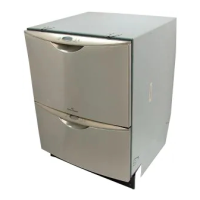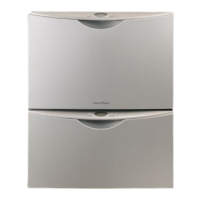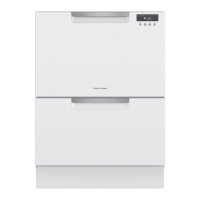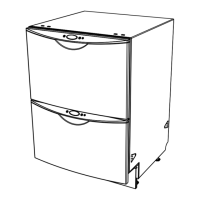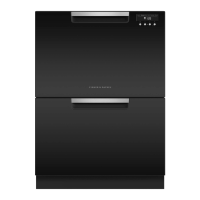
Do you have a question about the Fisher & Paykel DD602I and is the answer not in the manual?
| Dimensions (H x W x D) | 410 x 597 x 463mm |
|---|---|
| Noise Level | 45dBA |
| Delay Start | Yes |
| Half Load Option | Yes |
| Controls | Electronic |
| Type | Built-in |
| Product Type | Dishwasher |
| Energy Rating | 3.5 Stars |
| Water Rating | 4.5 Stars |
| Programs | Eco, Rinse |
| Features | Child lock |
Highlights the unique benefits and advanced technology of the Dish Drawer.
Explains how the Dish Drawer frees up counter space and offers flexible loading.
Details how interchangeable inserts allow custom rack configurations for different dish types.
Discusses the efficiency of washing small loads frequently, saving water and energy.
Explains the innovative detergent dispenser that pre-mixes water and detergent for dish protection.
Describes the spacious interior design allowing large plates and flexible loading of cups and glasses.
The basic insert required for washing dishes, holding other inserts and dishes above the spray arm.
A removable basket for cutlery, ideally placed over the drain filter opening.
A rack designed for glasses, cups, and small plates, adaptable for different needs.
An insert providing access to the drain filter while protecting the drawer base.
An insert for supporting plates and bowls, can be placed on either side of the basket.
Basic precautions for safe operation, including intended use, detergent handling, and loading sharp items.
Warnings about touching the heater plate and operating with enclosure panels in place.
Instructions not to tamper with controls or abuse the appliance, including sitting on it.
Precautions regarding children playing with the appliance and the risk of hydrogen gas in hot water systems.
Emphasizes installation by a qualified technician and proper grounding for safety.
Instructions to secure the appliance to the floor or joinery to prevent instability and potential injury.
Do not operate damaged units, store flammables nearby, or use extension cords.
Recommends authorized service agents for repairs and keeping the area clean and dry.
Do not open the drawer during operation; use Start/Pause and wait for beeps.
Use with all parts in place and disconnect by pulling the plug, not the cord.
Appliances are not toys; supervision is needed for children or those with limited abilities.
Do not wash contaminated items; turn off power/water if not used for a long time.
Keep the Use & Care Manual for future reference and with the appliance upon sale.
Identifies the Power, Start/Pause, and Lock buttons on the primary control panel.
Describes how the Power button turns the Dish Drawer on/off and terminates wash programs.
Details starting, pausing, and restarting the Dish Drawer, including lid seal inflation.
Explains how to start the drawer and run the last used wash program with a single button press.
Warns against opening the drawer during operation and explains safety mechanisms.
Describes how to activate/deactivate the lock to disable other functions, useful for cleaning or child prevention.
Allows delaying the start of a wash program from one to twelve hours for off-peak rates.
Step-by-step guide on how to set and cancel the delay start feature using the Start/Pause button.
Explains the advantage of independent drawers for different wash loads and program selection.
Describes how the Program button cycles through wash programs and indicator light colors.
Details the Rinse program for dishes needing rinsing before a later wash.
Recommends the Heavy Wash for heavily soiled dishes and cookware.
Suitable for normal everyday dishes with standard soil levels.
Designed for non-greasy, lightly soiled dishes.
A gentle program for lightly soiled and heat-sensitive crockery.
Explains Plus programs for better performance and Eco Save for energy saving.
Ensure filter, spray arm, and rinse agent are ready before loading and washing.
Instructions for scraping food, loading dishes, and avoiding overloading for optimal performance.
How to pour detergent into the dispenser and follow manufacturer's recommendations.
Steps for selecting wash programs and the optional Eco Save feature.
How to start the program using Start/Pause and how to pause it safely.
What happens at the end of a cycle and how power failures are handled.
Discusses basic inserts and how parts can be interchanged between drawers.
Explains the function of the basic basket insert.
Describes the purpose of the drain filter access panel.
Details the placement and use of the cutlery basket.
How the plate insert supports plates and bowls and its placement options.
Instructions for installing and using the Mega Rack, especially for wine glasses.
Tips on scraping food, avoiding overloading, placing small items, and slotting plates.
How to load long utensils and large bowls or pots when no inserts are used.
Ensure no items protrude to avoid damage when closing the drawer.
Positioning sharp items to prevent damage to the lid seal and risk of injury.
Note that loaded baskets/inserts are not designed to be lifted out.
How to place cups, glasses, and utensils on cup racks for optimal wash performance.
Specific guidance on placing wine glasses using the Mega Rack.
Mixing cutlery types and alternating handle directions for better washing.
Recommends placing sharp utensils with handles up to reduce cut injuries.
Advice on keeping stainless steel and silver separate to avoid staining.
Ensure no items block the spray arm path or slip through the cutlery basket.
Diagrammatic guidance for loading the top basket.
Diagrammatic guidance for loading the bottom basket.
Diagrammatic guidance for loading the cutlery basket.
Specifies recommended amounts of detergent for pre-rinse and main wash compartments.
Describes the two compartments for pre-wash and main wash detergent.
Explains the step markings for measuring detergent and suitability for powders.
Step-by-step instructions on how to open and fill the detergent dispenser.
Advises using only recommended dishwasher detergents and avoiding household cleaners.
Warns about the alkaline nature of dishwasher detergents and contact precautions.
Explains how rinse agent improves drying, prevents spots, and stops tarnishing.
Advises regular use of liquid rinse agent for best drying results and checking dispenser levels.
Specifies the location of the rinse agent dispenser inside the drawer.
Step-by-step guide on how to open, fill, and close the rinse agent dispenser.
Explains the meaning of the red light and the black window for rinse agent levels.
How to adjust the regulator based on water conditions to fix streaks or water marks.
Lists the settings that can be changed: Rinse Agent, Auto Power, and Water Pressure.
Step-by-step instructions to enter the adjustment mode using button combinations.
How to adjust the rinse agent setting using the Program button in the adjustment mode.
Describes how Auto Power automatically turns on the drawer when opened.
Instructions on how to turn the Auto Power feature on or off using the Lock button.
Explains how the Dish Drawer is programmed for water pressure and when to change it.
How to change water pressure settings using the Start/Pause button in the adjustment mode.
Warning against setting low pressure (LP) for high/standard water pressure to avoid damage.
Details various wash programs like Rinse, Heavy, Normal, Fast, Delicate, and their applications.
Specifies the recommended detergent quantities (tsp) for each wash program.
Explains the meaning of red and green indicator lights for Plus and Eco Save programs.
Advises on adjusting detergent for soft water and the importance of correct amounts.
Suggests a water softener for hard water areas to improve quality and prevent build-up.
Recommends leaving drawers ajar after cycles to improve drying efficiency.
Emphasizes that insufficient detergent causes poor performance, while excessive detergent doesn't improve results.
Specifies that for Fast Eco Save, detergent should only be in the main wash compartment.
Explains the drying fan's short operation after cycles to assist drying with minimal energy.
Explains the kickstrip's design to release if large items obstruct closing.
Step-by-step instructions for reinstalling the upper kickstrip by fitting tabs into slots.
Warns that high temperatures and detergent can damage some items; consult manufacturers or hand wash.
Guidance on washing everyday glassware and caution for crystal or antique items.
Advises rinsing cutlery immediately, avoiding contact with stainless steel, and hand drying silver.
Notes that aluminum can be dulled by dishwasher detergent depending on product quality.
Information on potential rusting or staining of iron, cast iron, copper, pewter, and brass.
General advice that wooden items are sensitive to heat/water and may deteriorate with regular use.
Caution for plastics changing shape/color; weigh down items to prevent flipping.
Advice for china patterns, antique items, and glued items, suggesting hand washing if unsure.
How to wipe down the secondary panel and drawer front with a damp cloth.
Lists cleaning agents (scouring pads, solvents, acids, etc.) not to use as they can damage the drawer.
Recommends a Heavy Plus wash with detergent after using a dishwasher cleaner.
Recommends cleaning these parts when food particles are evident or monthly.
Step-by-step guide to remove, clean, and replace the drain filter.
Instructions for removing, cleaning, and reinstalling the spray arm.
Step-by-step instructions for removing, cleaning, and reinstalling the filter plate.
Instructions for cleaning the motor assembly, typically for fault conditions, and checking for foreign matter.
Emphasizes that the Dish Drawer must be used with motor assembly, filter plate, and spray arm correctly in place.
Recommendations for preparing the drawer for periods of non-use, including cleaning and turning off supplies.
Troubleshooting steps for power supply, drawer closure, lock, and Start/Pause button issues.
Solutions for drain hose kinks or blockages in the filter plate/drain filter.
Troubleshooting for water faucet being off or inlet hose kinks.
Advice on checking rinse agent levels and adjusting the rinse agent setting.
Ensure dishes are not nesting together for proper washing.
Recommendation to decrease the amount of detergent used.
Troubleshooting for overloading, unsuitable/insufficient detergent, spray arm issues, and blocked filters.
Refer to the wash program chart for suitable programs or if soils need soaking.
Refer to User Maintenance for correct insertion of filter plate and drain filters.
Detergent must be placed in the large compartment; check instructions.
Promptly start the drawer after dispensing liquid detergents.
Scrape all food scraps off dishes before loading.
Refer to Dish Drawer Accessories section for correct Mega Rack installation.
Addresses foaming due to incorrect detergent amount or too much egg yolk in the wash load.
Solutions for dishes not drying, including rinse agent setting and program choice.
Troubleshooting for detergent not dispensing, including wet detergent and dispenser dryness.
Specific advice for the Fast Eco Save program regarding detergent placement.
Troubleshooting for drain hose disconnection, inlet hose connection, and other leaks.
Advice on pre-rinsing or using the rinse program to minimize staining from certain foods.
Refers to User Maintenance for foreign matter in the motor assembly or incorrect part placement.
How to clear the U2 fault by pressing Power after closing the drawer.
Troubleshooting for incorrect water pressure, blocked drain pump, and installation errors.
Solutions for fill faults, incorrect installation, blocked inlet hose, and very low water pressure.
Instructions to turn off power/water and call for service if the flood switch is activated.
Guidance for motor problems and incorrectly installed motor assembly or related parts.
Checks for inlet water supply temperature and faulty temperature sensor.
Advises calling service agents for faulty temperature sensors or electronic malfunctions.
Details the two-year smart care warranty covering parts and labor for manufacturing defects.
Lists exclusions like user error, improper installation, misuse, accidents, and normal maintenance.
Explains limitations on incidental or consequential damages and user's legal rights.
States that proof of original purchase is required for warranty service.
Provides contact details for authorized service agents and the company website.


